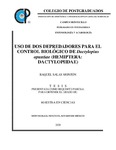| dc.contributor.author | Salas Monzón, Raquel | |
| dc.creator | SALAS MONZÓN, RAQUEL; 884731 | |
| dc.date.accessioned | 2020-09-22T17:33:52Z | |
| dc.date.available | 2020-09-22T17:33:52Z | |
| dc.date.issued | 2020-04 | |
| dc.identifier.uri | http://hdl.handle.net/10521/4293 | |
| dc.description | Tesis (Maestría en Ciencias, especialista en Entomología y Acarología).- Colegio de Postgraduados, 2020. | es_MX |
| dc.description.abstract | La cochinilla silvestre del nopal, Dactylopius opuntiae, es una plaga clave de Opuntia ficus-indica en México y otros países del mundo, y se busca como mejorar su control. Hyperaspis trifurcata y Leucopina bellula son enemigos naturales específicos de D. opuntiae ambos tienen potencial como agentes de control biológico, pero se desconoce el comportamiento de alimentación e interacción cuando se encuentran de manera simultánea. En este trabajo se determinó la interacción entre H. trifurcata y L. bellula cuando forrajeaban a la presa en un mismo lugar y al mismo tiempo. Usando experimentos de elección y no elección se determinó que ambos depredadores consumieron todos los estados de desarrollo de su presa, con preferencia hacia los estados inmaduros. Leucopina bellula consumió proporcionalmente más ninfas de primer o segundo ínstar (0.16 y 0.14, respectivamente) que adultas no grávidas (0.007). Mientras que H. trifurcata consumió de manera similar las ninfas de primer y segundo ínstar (0.33 y 0.23), pero menos que adultas (0.05). La proporción de consumo fue mayor cuando ambos depredadores se liberaron de manera conjunta, en comparación con los tratamientos de liberación individual en cualquier etapa de desarrollo de D. opuntiae. La interacción de ambos depredadores fue aditiva en el consumo de ninfas de primer ínstar y adultas grávidas de D. opuntiae, pero fue sinérgica en el consumo de huevos. En este trabajo se discuten las implicaciones de estos resultados para emplear a estos dos depredadores en el control biológico de D. opuntiae. _______________ USE OF TWO PREDATORS FOR THE BIOLOGICAL CONTROL OF Dactylopius opuntiae (HEMIPTERA: DACTYLOPIIDAE). ABSTRACT: The wild cochineal, Dactylopius opuntiae, is a key pest of Opuntia ficus-indica in Mexico and other countries around the world, and some way to improve its control is needed. Hyperaspis trifurcata and Leucopina bellula are specific natural enemies of D. opuntiae that have potential as biological control agents, but the feeding and interaction behavior when they are found simultaneously is unknown. In this work, the interaction between H. trifurcata and L. bellula was determined when they foraged its prey simultaneously. Using choice and non-choice experiments we determined that both predators consumed all the development stages of D. opuntiae, with preference towards the immature stages. Leucopina bellula consumed proportionally more first or second instar nymphs (0.16 and 0.14, respectively) than no gravid adults (0.007). Hyperaspis trifurcata similarly consumed the first and second instar nymphs (0.33 and 0.23), but less than adults (0.05). The proportion of consumption was higher when both predators were released together, compared to individual release treatments at any stage of D. opuntiae development. The interaction of both predators was additive while consuming first instar nymphs and gravid adults of D. opuntiae, but was synergistic in the consumption of eggs. The implication of these results for employing these two predators in biological control of D. opuntiae is discussed. | es_MX |
| dc.description.sponsorship | Consejo Nacional de Ciencia y Tecnología (CONACyT). | es_MX |
| dc.format | pdf | es_MX |
| dc.language.iso | spa | es_MX |
| dc.rights.uri | http://creativecommons.org/licenses/by-nc-nd/4.0 | es_MX |
| dc.subject | Cochinilla silvestre del nopal | es_MX |
| dc.subject | Control biológico | es_MX |
| dc.subject | Hyperaspis trifurcata | es_MX |
| dc.subject | Leucopina bellula | es_MX |
| dc.subject | Interacciones | es_MX |
| dc.subject | Wild cochineal | es_MX |
| dc.subject | Biological control | es_MX |
| dc.subject | Interactions | es_MX |
| dc.subject | Entomología y Acarología | es_MX |
| dc.subject | Maestría | es_MX |
| dc.subject.classification | BIOLOGÍA Y QUÍMICA::CIENCIAS DE LA VIDA::BIOLOGÍA DE INSECTOS (ENTOMOLOGÍA)::DESARROLLO DE LOS INSECTOS | es_MX |
| dc.title | Uso de dos depredadores para el control biológico de Dactylopius opuntiae (Hemiptera: Dactylopiidae). | es_MX |
| dc.type | Tesis | es_MX |
| Tesis.contributor.advisor | Rodríguez Leyva, Esteban | |
| Tesis.contributor.advisor | Lomelí Flores, J. Refugio | |
| Tesis.contributor.advisor | Vanegas Rico, Juan Manuel | |
| Tesis.date.submitted | 2020-04 | |
| Tesis.date.accesioned | 2020 | |
| Tesis.date.available | 2020 | |
| Tesis.format.mimetype | pdf | es_MX |
| Tesis.format.extent | 560 KB | es_MX |
| Tesis.subject.nal | Insectos depredadores | es_MX |
| Tesis.subject.nal | Predatory insects | es_MX |
| Tesis.subject.nal | Opuntia ficus-indica | es_MX |
| Tesis.subject.nal | Dactylopius | es_MX |
| Tesis.subject.nal | Control biológico de plagas | es_MX |
| Tesis.subject.nal | Biological pest control | es_MX |
| Tesis.subject.nal | Enemigos naturales | es_MX |
| Tesis.subject.nal | Natural enemies | es_MX |
| Tesis.rights | Acceso abierto | es_MX |
| Articulos.subject.classification | Insectos como agentes biológicos para el control de plagas | es_MX |
| dc.type.conacyt | masterThesis | es_MX |
| dc.identificator | 2||24||2413||241302 | es_MX |
| dc.contributor.director | RODRÍGUEZ LEYVA, ESTEBAN; 35425 | |
| dc.audience | generalPublic | es_MX |


